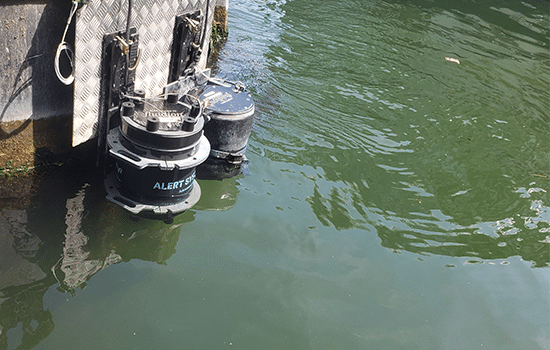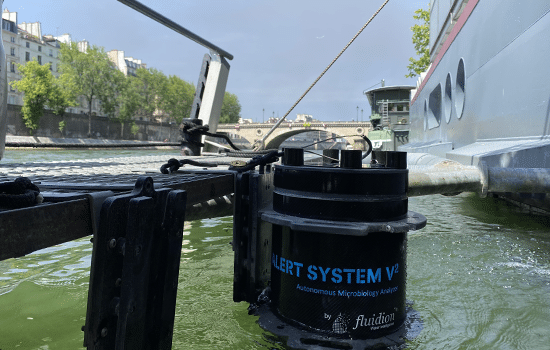In this journey toward the Paris 2024 Olympic Games, innovation takes center stage, extending its reach from intricacies like sensors monitoring the quality of the Seine River to the comprehensive oversight of all digital facets of the event. Acknowledged as the “most connected” Olympics to date, Paris 2024 serves as a testament to the seamless integration of technology and sports. This article delves into the transformative influence of the IoT and digital transformation and spotlights two French companies that are actively shaping this groundbreaking convergence.
Paris is planning to lift a century-old swimming ban on the Seine just in time for the 2024 Olympic Games when selected stretches of the river should be used for open-water swimming and triathlon events. Following the Olympics, the city plans to reopen the river for public swimming in 2025.
Dipping in Paris’s main waterway has been forbidden since 1923 due to the Seine’s pollution levels, which are severely affected by rainfall events and overspill from the city’s complex and dated sewer system. The effort to clean up the river is backed by a 1.4 billion euro “Swimming Plan”, which aims to reduce the public safety risk of swimming by lowering the level of dangerous bacteria such as E. coli or intestinal Enterococci.
On one side, the city had to work on pollution mitigation by focusing on collecting wastewater from about 20.000 homes and 170 boats that in the past year still discharged into the river. On the other hand, much work has gone into scaling up the monitoring systems that let the city officials monitor the Seine’s pollution level with unprecedented precision.
Fluidion: Using IoT to Monitor the Seine River
The technology behind this effort is a network of IoT measurement devices and sensors developed by Fluidion, a deep-tech French company that develops autonomous water quality measurement solutions and microbiology & chemistry sensors. Thanks to the Fluidion ALERT system placed in key locations along the river, the city of Paris has moved away from the traditional methods of grab sampling and laboratory analysis. Instead, Fluidion provided an always-on, automated, cost-effective solution that streamlines real-time and high-frequency data to align with the Olympic committee’s strict safety requirements.
As the company explains on its website:
“Fluidion was able to respond to significant rain events and monitor CSO events with high-frequency sampling to accurately chart pollution dynamics and measure concentration peaks through detailed pollutographs – a feat achievable only with an automated analyzer like the ALERT System. Fluidion ALERT technology also indicated the duration for water quality to recover to its baseline quality levels”.
Fluidion expanded its efforts beyond merely providing the tools and sensors. The company has also been in charge of continuous surveillance initiatives at strategic points along the Seine, notably near landmarks like the Bibliothèque Nationale, Pont de Iéna, Pont Marie, and Pont Alexandre III – the anticipated venues for Olympic swimming events.



The ALERT System
The ALERT system consists of dual in-situ bacteria sensors that enable daily assessments. Initially spanning several periods during the year, the surveillance eventually focused on the summer months (June to October), a critical time for the Olympics and the Swimming Plan of 2025.
The company’s ALERT analyzers are IoT systems designed for quick and effortless setup and can be installed in any setting without specific infrastructure. These devices could either float or be mounted on custom-designed tracks, providing the flexibility needed to meet the city’s operational needs.
Such measurements have already proven helpful during the recent Olympic tests in the Summer. Back in August, due to unexpected and heavy rainfall, the monitoring system had deemed the level of bacteria in the Seine to be unsafe for the Open Water Swimming Word Cup to take place. While the event was canceled, later tests proved the river was safe to swim again so that another round of competitions could occur. On the one hand, the cancellation of the planned events proves that the Paris authorities still have a lot of work to do to make sure the Seine will be consistently swimmable in time for the 2024 Olympics; on the other hand, it proved the efficiency and effectiveness of IoT based high-frequency sampling, which allows for quick location specific data collection allowing for time-sensitive decision making.
Atos: Managing the Digital Aspects of the Event
The deployment of IoT sensors for high-frequency water quality testing is just one of the many ways the Olympics and Paralympics games leverage technology to help manage the complexity of the most important sports event globally. The “silent partner” that made it possible for the International Olympic and Paralympic Committee (IOC and IPC) to embrace digital transformation seamlessly over the years is another French company, the multinational services provider Atos.
The global IT giant has collaborated as the main tech provider with the IOC and IPC for over 25 years. During the latest edition of the Games, in Tokyo, ATOS was responsible for all digital aspects of the event, including managing the safe transmission of competition results instantly and securely, processing the volunteer portal, issuing accreditations, and managing the biometrics entry points at all the competition and non-competition venues for accredited athletes and other participants.
To be ready when the starting guns go off in July 2024, Atos has devised more than 250.000 hours of testing of the digital and technical infrastructure deployed for the Olympic Games.
According to Patrick Adiba, Senior Executive Vice-President and Head of Major Events at Atos:
“Paris 2024 looks set to be the most ‘connected’ in the history of the Olympic and Paralympic Games. To this end, our ITL teams are fully mobilized with the Olympic authorities and their technological partners during this critical testing stage. During such phases, we are increasing data volumes in anticipation of the demands on our systems to ensure their reliability.”

A Dedicated SOC for Cybersecurity
Given its nature as the “most connected” edition of the Games, Paris 2024 and the IOC/IPC also represent a prime target for cybercriminals. For this reason, Atos has placed an additional focus on securing the organizations’ operations and the games to fend off as many cyber threats as possible.
Based on a rigorous risk assessment, the company provided a complete cybersecurity plan for the Olympics. A dedicated Security Operations Center will continuously monitor cyber incidents while the “Computer Security Incident Response Team” will always be ready on call to quickly escalate an intervention in case of an actual attack.
The company also established a “Global Threat Intelligence service” tasked with pre-empting attacks by analyzing and monitoring possible threat actors on the internet and the Dark Web. Additionally, the “Security Information and Event Management” will analyze security-related events generated by the IT network in real-time, while a series of “Endpoint protection services” will make sure the device and communications system of employees and officials are as secure as possible at all times.
Last but not least, Atos has provided extensive cybersecurity training to IOC employees to ensure the highest level of cyber vigilance throughout the event.











